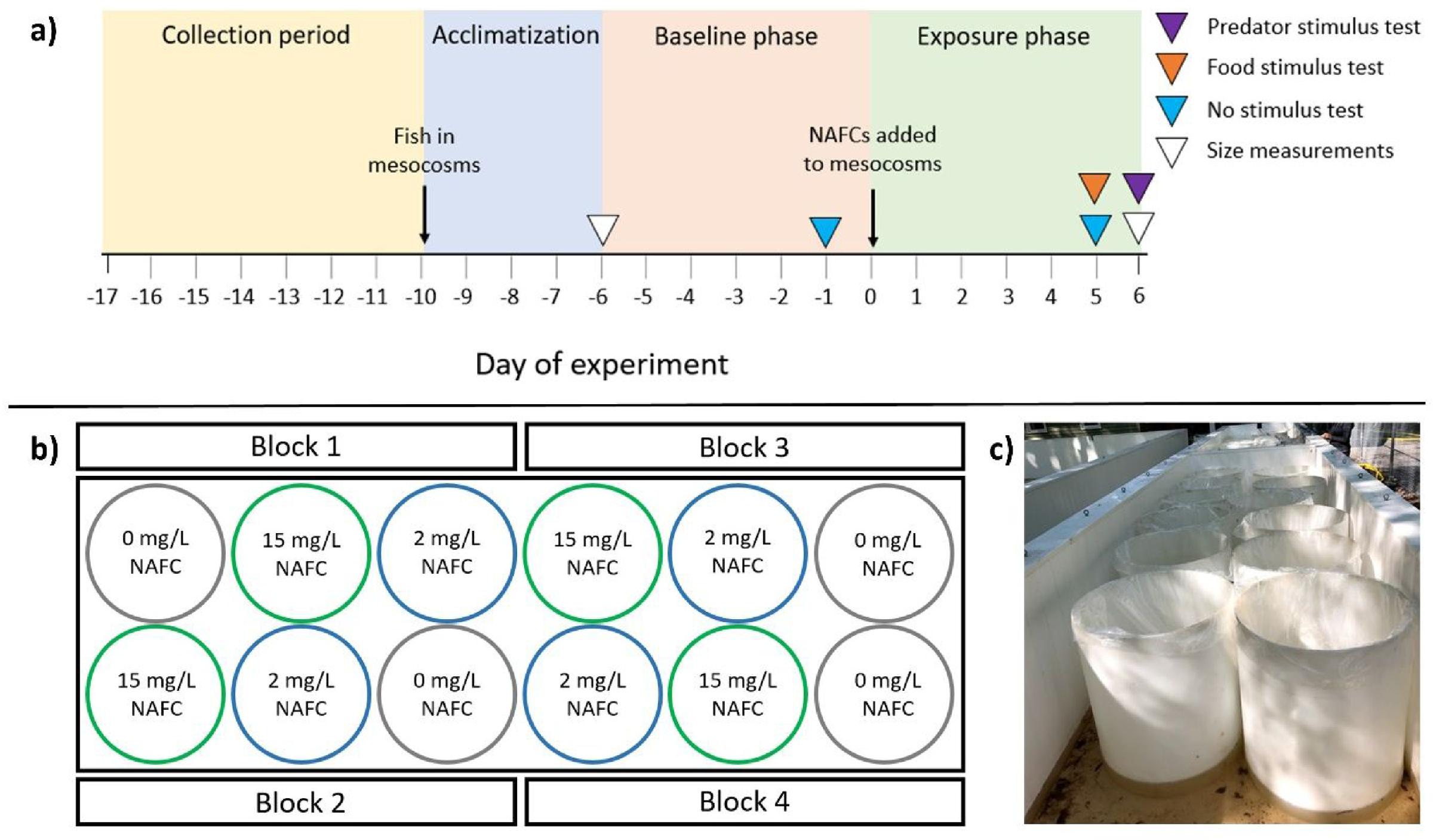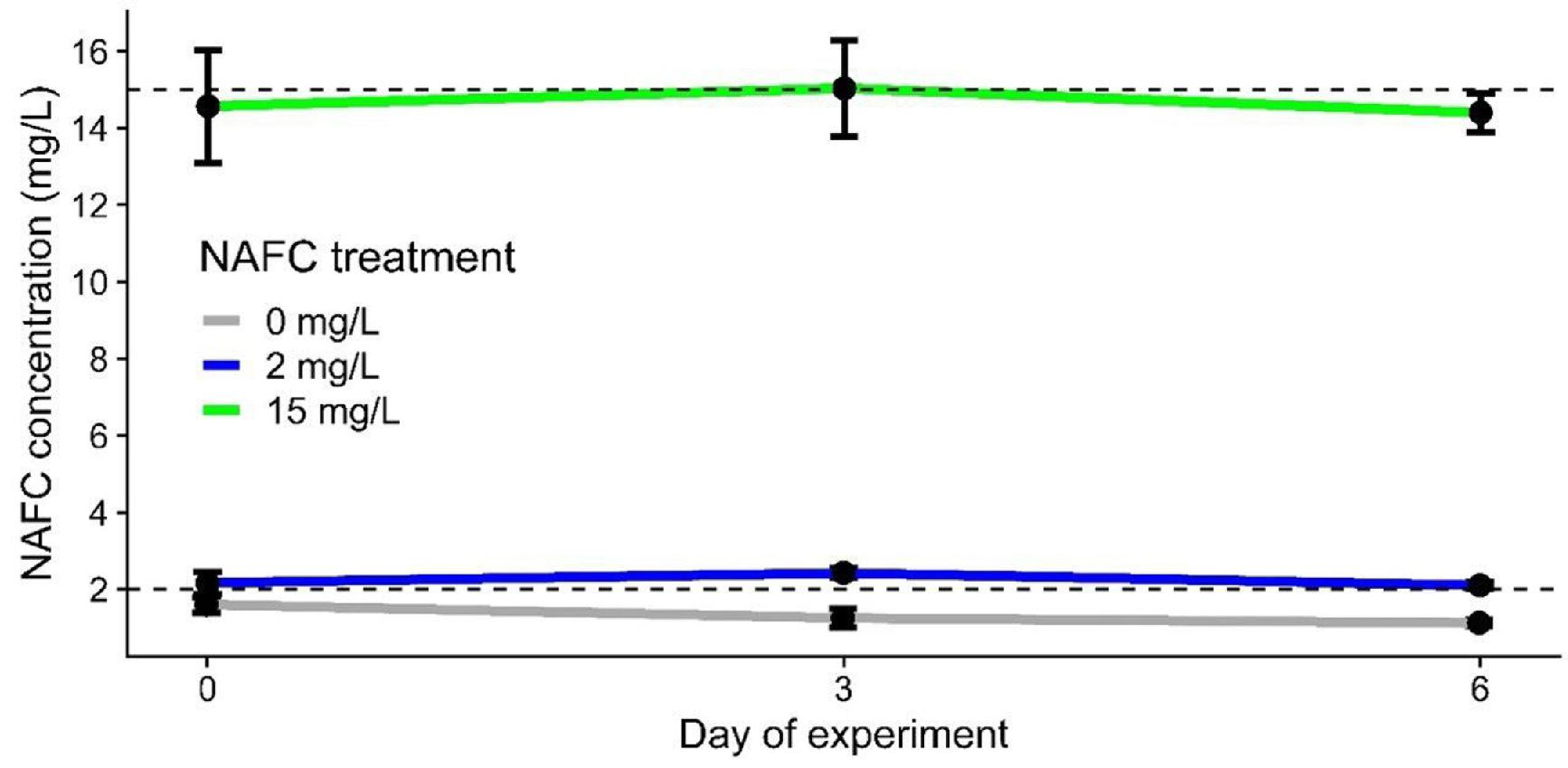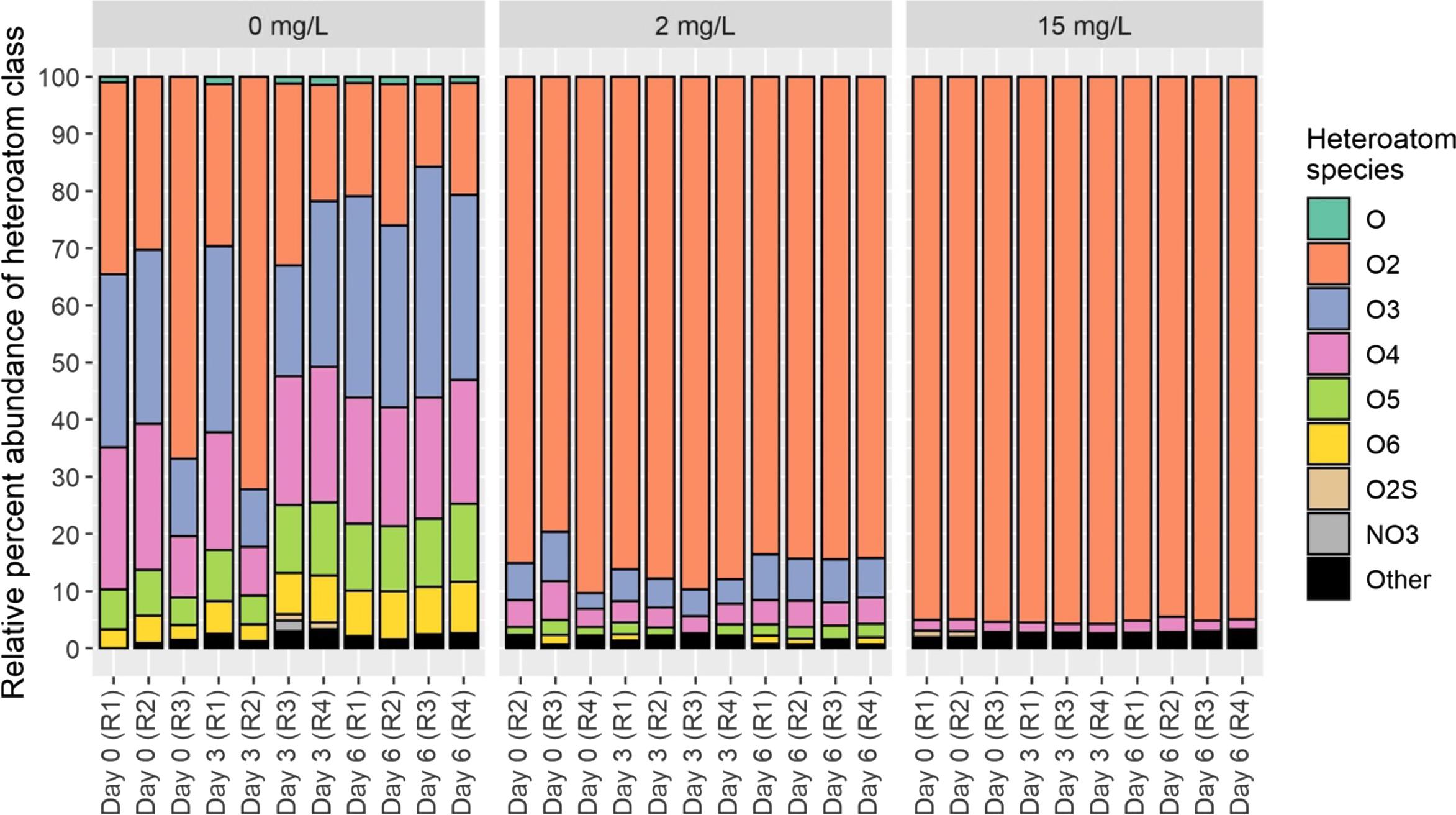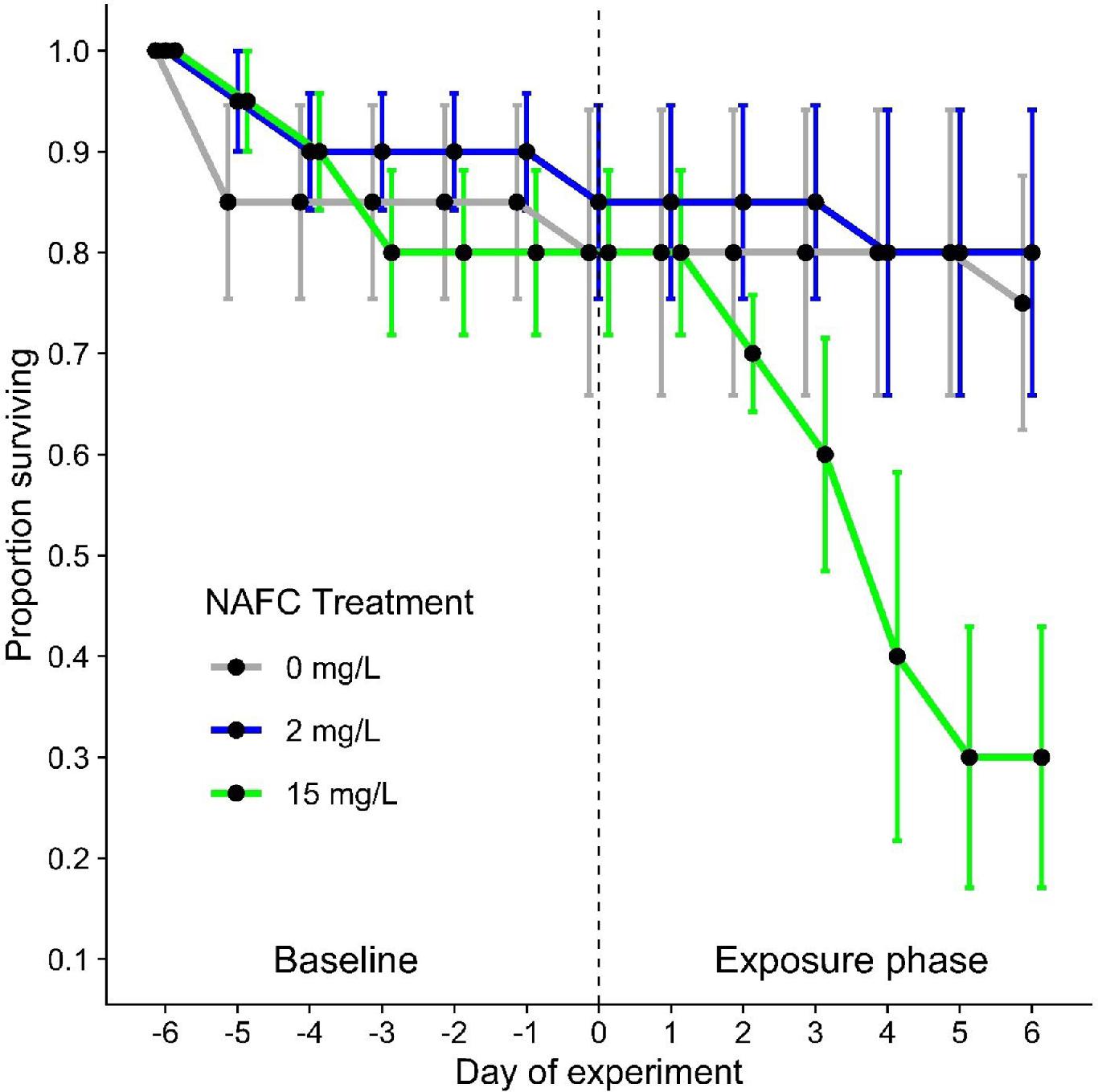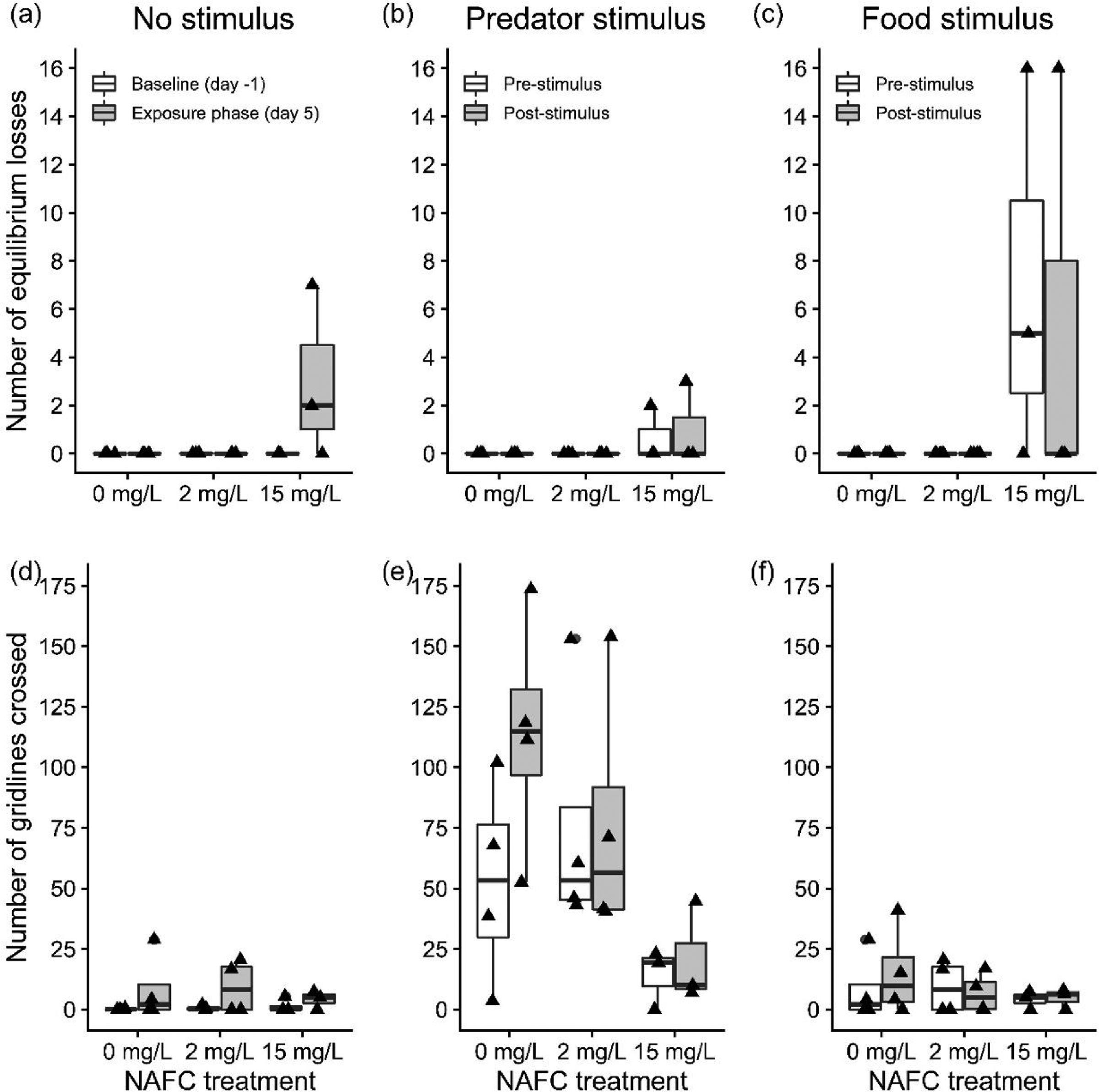The occurrence of equilibrium losses in yellow perch was significantly influenced by NAFC exposure in the three behavioural tests (
Figs. 5a–5c), with fish in the 15 mg/L NAFC treatment being the only ones to lose equilibrium. In the no-stimulus activity test during the baseline phase, no equilibrium losses were observed, whereas fish in two out of three replicate mesocosms in the 15 mg/L treatment did lose equilibrium during the exposure phase (one twice and one seven times;
Fig 5a), driving a significant effect of treatment in the exposure phase (GLM,
F2,8 = 10.79,
P = 0.0053). In the predator stimulus test, equilibrium losses significantly increased with NAFC exposure during both the pre-predator stimulus and post-predator stimulus periods (GLM, both
F2,8 = 5.19,
P = 0.036), although these equilibrium losses occurred in only one of the 15 mg/L NAFC replicate mesocosms (twice pre-predator stimulus and thrice post-predator stimulus;
Fig. 5b). In the food stimulus test, equilibrium losses again occurred exclusively in the 15 mg/L treatment in both the pre-food stimulus (GLM,
F2,8 = 11.4,
P = 0.0046) and post-food stimulus (GLM,
F2,8 = 5.19,
P = 0.036) periods (
Fig. 5c). Equilibrium losses have also been observed in juvenile pink salmon exposed to crude oil, which is notable as NAFCs are found in oil residues (
Yang et al. 2021).
Reynolds et al. (2022) observed similar equilibrium losses in recently hatched fathead minnows exposed to 21 and 29.5 mg/L of NAFCs, concentrations that were also associated with higher rates of mortality. One study suggests that loss of equilibrium in fish can serve as an alternate endpoint that can identify a larger portion of the population that is under stress and potential forthcoming mortality (
Gosselin and Anderson 2020). If OSPW and NAFCs are released, fish in the Canadian oil sands region would not likely be statically exposed to contaminants as they were in this study, and thus it is relevant to understand both the immediate effects on survival and the changes in behaviour that decrease survival over time.
NAFC impacts on other behavioural endpoints
Examination of other behavioural endpoints (i.e., shoaling score [Figs. S5a–S5c], number of burst swim events [Fig. S5d–S5f], freezing time [Figs. S6a–S6c], and space use score [Figs. S6d–S6f]) yielded equivocal evidence that NAFC exposure caused alterations in these behaviours. In the no-stimulus activity test, fish shoaling score was independent of treatment in the baseline (GLM, F2,9 = 0.13, P = 0.88) and exposure (GLM, F2,7 = 2.41, P = 0.16) phases, with a marked decrease in shoaling in the 15 mg/L treatment during exposure (Fig. S5a). Similarly, during the predator stimulus test, shoaling scores were not significantly influenced by treatment in either the pre-predator stimulus (GLM, F2,7 = 0.86, P = 0.46) or the post-predator stimulus (GLM, F2,6 = 2.47, P = 0.15) periods, although there were trends towards greater shoaling scores post-predator stimulus in the two NAFC treatments compared to the controls (Fig. S5b). In the food stimulus test, shoaling scores differed significantly between treatments both pre-food stimulus (GLM, F2,7 = 5.54, P = 0.036) and post-food stimulus (GLM, F2,7 = 5.09, P = 0.043) periods, with these differences driven by shoaling scores that were 40%–50% lower in the shoals of fish exposed to 15 mg/L NAFCs compared to the 2 mg/L and control treatments (Fig. S5c). By the end of the experiment, there were notably smaller sample sizes of fish in the 15 mg/L NAFC treatment due to greater mortality. One replicate in the 15 mg/L treatment had 100% mortality, and one replicate had only one fish live to the end of the experiment, and thus this replicate could not be included in shoaling assessments during behavioural tests. In addition, observed changes in shoaling cannot be attributed to the food stimulus, as similar patterns of effect were found in both the pre- and post-food stimulus periods. Therefore, it is not conclusive if the observed change in shoaling was indeed a consequence of NAFC exposure.
The total number of burst swims did not differ significantly between NAFC treatments in any behavioural test (all P > 0.05; Fig. S5d). In the predator stimulus test, there were no differences in burst swims between treatments pre-predator stimulus (GLM, F2,8 = 1.04, P = 0.39), but there were significant differences between treatments post-predator stimulus (GLM, F2,8 = 5.38, P = 0.033), with the greatest number of burst swims observed in the control treatment (Fig. S5e). Fish in the food stimulus tests did not demonstrate any significant differences in burst swims between treatments in either the pre- or post-food stimulus periods (both P > 0.05; Fig. S5f).
Time spent frozen did not change significantly between NAFC treatments in any behavioural test (all P > 0.05), although times were uniformly greater during the exposure phase (175 ± 28 s, mean ± SD across all treatments) compared to the baseline phase (0 s) in the no-stimulus activity test (Fig. S6a). Freezing time during the predator stimulus test did not vary significantly between treatments in either the pre- (GLM, F2,8 = 2.0, P = 0.0.19) or post-predator stimulus (GLM, F2,8 = 1.09, P = 0.38) periods, although fish in the 15 mg/L treatment tended to spend more time frozen compared to the other groups in both sampling periods. Freezing time during the food stimulus did not vary between treatments in either period (all P > 0.05; Fig. S6c).
Space use as indicated by location score did not vary significantly between treatments in any behavioural test (all P > 0.05 (Figs. S6d–S6f), although location scores were consistently lower in the predator test (Fig. S6e) compared to the no-stimulus activity (Fig. S6d) and food stimulus (Fig. S6f) tests.
During the food stimulus test, space use and proximity to the food stimulus location did not vary significantly between treatments in either the pre-food stimulus (GLM,
F2,8 = 1.42,
P = 0.29; Fig. S7) or post-food stimulus (GLM,
F2,8 = 1.33,
P = 0.32; Fig. S7), indicating that fish did not change locations when a food stimulus was added to the mesocosm. Our findings are similar to those of
Philibert et al. (2019), who found no difference in distance travelled or prey captured by fish exposed to OSPW during development. However, our findings contrast with those reported by
Lari and Pyle (2017), who found that OSPW exposure impairs food searching behaviour in fish by disrupting their perception of foraging cues. The lack of response to a food stimulus that we observed may be attributed to the conditions of the behaviour tests rather than the potential effects of NAFC exposure. A lack of response to the food stimulus may have occurred because fish were fed daily and excess food was not removed from the test tanks. As such, fish had constant access to food throughout the day and may not have been motivated to respond overtly to the food stimulus during behavioural trials. As the ability to capture prey is essential for survival and is a complex behaviour that relies on visual perception, recognition, decision-making, and motor control (
Muto and Kawakami 2013), future studies with adjusted methods may be warranted to further investigate if NAFCs can alter foraging behaviour in fish.
